Net dollar retention measures the amount of revenue that you keep and expand in your existing customer base. Net dollar retention (NDR) along with gross dollar retention (GDR) have become popular metrics in the valuation world.
Retention is Pillar 2 of my 5 Pillar SaaS Metrics Framework. Retention is critical to track, monitor, and improve the health of our recurring revenue streams. This data also becomes especially important in the due diligence process. Net dollar retention is often referred to as net revenue retention.
Net dollar retention is a “must-have” metric in your monthly reporting package.
In this post, I cover the what, why, and how of net dollar retention, a critical metric for your SaaS business. Plus, I have a great Excel template download below that will perform the revenue retention calculations for you.
What is Net Dollar Retention
Net dollar retention focuses just on our existing customer base. We do not include any new customer dollars in the calculation. But we can take credit for the expansion within our existing customer base.
Net dollar retention measures the amount of revenue that you keep from your existing customer base and expand within your existing customer base.
I think of it as the health of our recurring revenue and customer base. However, it’s really two stories in one metric.
We could be great at pure retention. Meaning, we can keep customers on our product. But we could be horrible at expanding those customers in the form of upsell and/or cross-sell. Or maybe, it’s the flip side of that.
NDR measures the churn (completely lost customers), contraction, and expansion dollars inside our customer base. NDR can be less than 100% or greater than 100%. The higher the percentage the better.
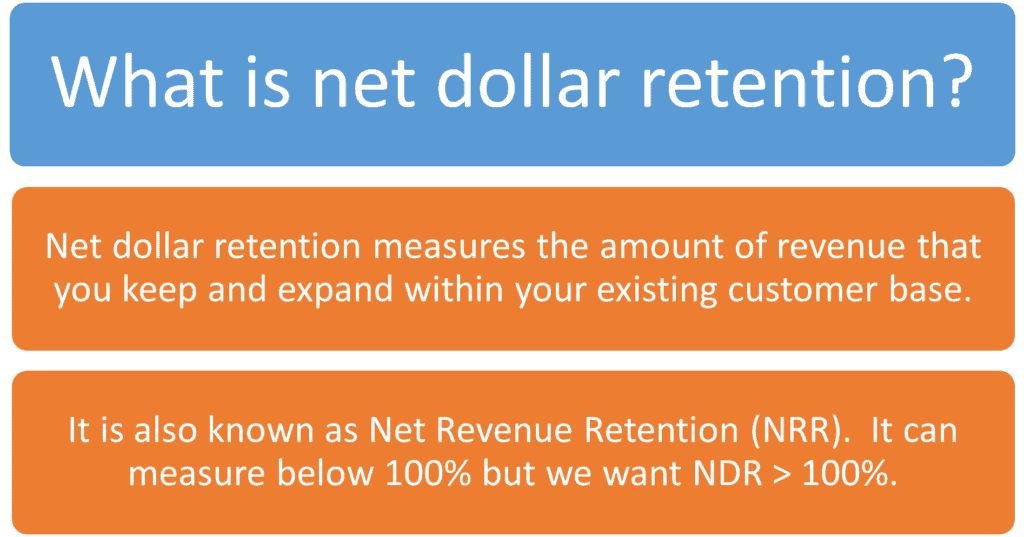
There are two primary methods to calculate NDR. You can calculate retention in aggregate using your total recurring revenue. Or you can calculate on a cohort basis.
Cohort analysis limits retention analysis to a specific group of customers. This is typically measured and grouped by the month of customer acquisition. We then track the performance of that same cohort over time.
I have also calculated NDR on a bookings basis from CRM data. However, this requires opportunity tracking from day one, ideally, of your SaaS company. And it requires strict data integrity with your CRM opportunities.
How to Calculate to Net Dollar Retention (NDR)
Net dollar retention measures lost and expansion dollars from your existing customer base. Lost dollars mean churn and downgrades. Churn is completely lost customers. Downgrades are the net dollars lost when a customer, for example, reduces the number of seats, modules, usage tiers, and so on. Expansion dollars can be selling more of the same product (upsell) or selling another product line (cross-sell) to your existing customer.
The formula to calculate NDR is below. I use MRR in the formula, but you can replace MRR with ARR if you think in ARR terms.

You can see how this formula works in practice in the screenshot below. We sum our churn and downgrade dollars and divide that by our beginning MRR balance (BoP $). In the example below, I am calculating NDR monthly.
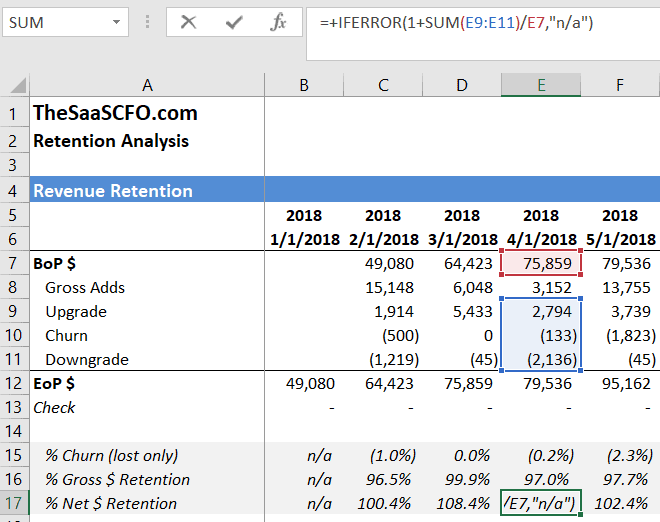
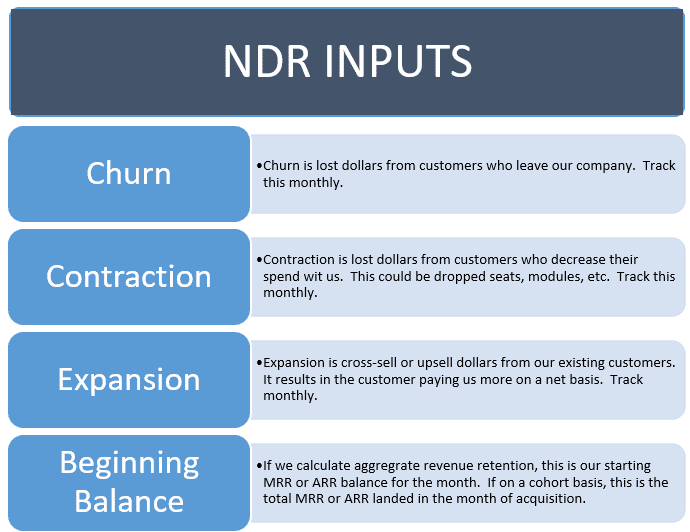
Why Do We Care About Net Dollar Retention
Recurring revenue is the engine of our SaaS business. We must monitor the health of this engine and adjust the engine if performance declines.
Operators and investors love stable, recurring revenue streams. And if we can efficiently expand our customer base, all the better.
Valuations are tied to the health of our recurring revenue. Great retention provides consistent cash flows and more time to fix issues in our business.
- Poor retention has several downline impacts. It leads to the following financial impacts.
- Lower customer lifetime values because we use churn (1 – GDR) in the denominator of the LTV equation. Poor retention puts more pressure on your new business development team to perform.
- We need more new business bookings to offset the churn deficit and hit our revenue growth targets.
- It puts more pressure on gross margins, increases CAC payback periods, and stresses our P&L.
Revenue retention is also a key due diligence item if you are fundraising or selling your company. High gross dollar retention and net dollar retention will support your valuation, so make sure you have this data in order. Typically, three years of retention data is requested.
I Calculated Net Dollar Retention, Now What
In my SaaS Metrics Foundation course, we have great discussions on interpreting the results of retention analysis. We calculated NDR. Now what do we do with it?
In the screenshot below, I highlighted in red several months where GDR appears to trend below historical averages. Students in my course asked, “what do I about this?”
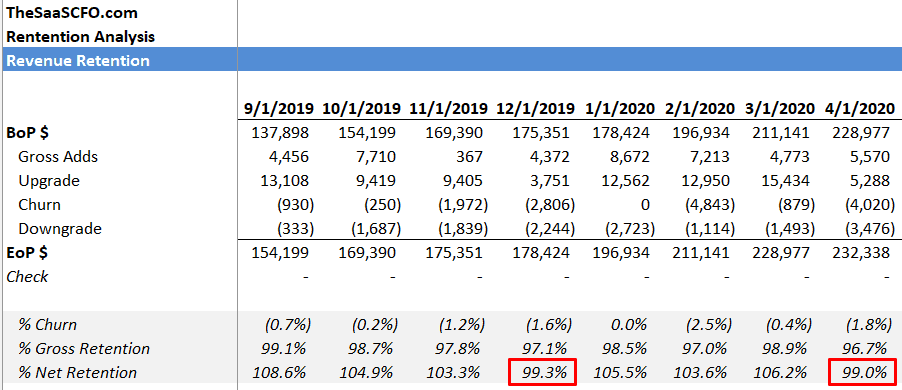
My response…the numbers only tell you half the story. We must dig in operationally with our department executives to understand why. We repeat this process each month. Measure, monitor, and take appropriate action if necessary.
We need to marry the numbers to the operational story to tell the full financial story.
What are the reasons for churn?
- Do we have onboarding issues?
- Do we have technical support issues?
- Do we have product issues?
- Do we have a cohort of customers who were not a good fit for our product?
How is expansion performing?
- Do we have a dedicated account management team?
- Are we expanding efficiently or inefficiently?
- How does the sales team interact with the customer success team?
- Who is responsible for retention?
With this information, I can determine what resources or investments that might be required to stabilize and improve retention. I will also adjust my financial forecast accordingly and determine the impact to our margins, cash flow, and related SaaS metrics
Net Dollar Retention Benchmarks
I consider best-in-class net dollar retention to be 120% and above. This assumes we are targeting mid-market and enterprise customers. My rule of thumb is greater than 120% for larger customer contract values and greater than 100% for smaller price point, high volume businesses.
When I benchmark my SaaS clients, I use the latest SaaS metrics benchmarks from Ray Rike, founder of RevOpsSquared.com. I benchmark by company ARR size and by our products average selling price (ASP).
Aggregate benchmarks (not filtered based on your company profile) provide nice, general ranges. However, should benchmark your business based on your profile (ACV size, etc.). You can benchmark your SaaS business by visiting SaaSKPIBechmarks.com.
Which Revenue Streams Apply to Retention Analysis
We can perform revenue retention analysis on several streams. Of course, retention analysis started with our contracted MRR or ARR revenue stream. But what about variable revenue streams?
Variable revenue streams could include usage, processing, transaction, and so on. I’ll perform retention analysis on each variable revenue stream to determine if we have any consistency and predictability.
We want to frame up our variable revenue streams as predictable as our fixed MRR/ARR contracts.
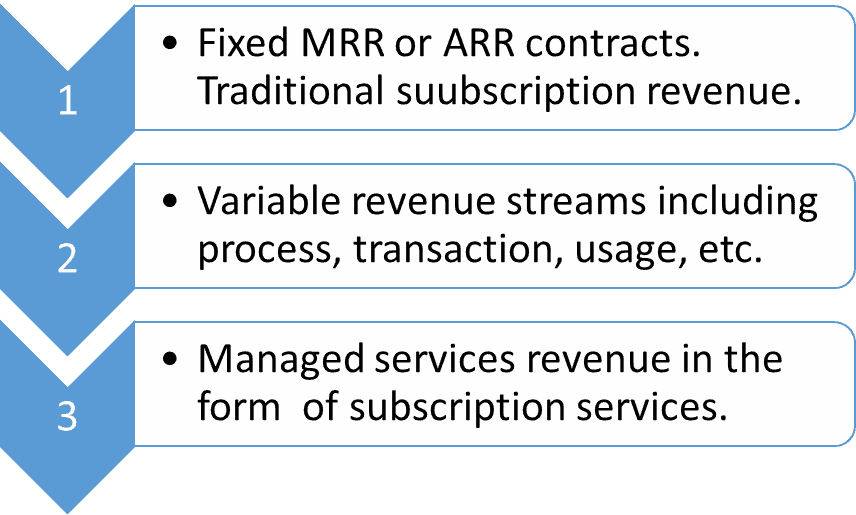
Lawsuit Against Freshworks Over Net Dollar Retention
We know that SaaS metrics are relied on by investors. In this case, a lawsuit claims that Freshworks presented metrics in its S-1 filing that had peaked. They explicitly call out net dollar retention in the lawsuit.
After reviewing the S-1 filing, it’s hard to discern if Freshworks calculated NDR incorrectly or rather stated an NDR number that might be challenging to maintain in the future.
You can see the NDR performance pre and post-IPO in the chart below. I don’t know the inner details of this case, but it highlights the importance of SaaS metrics when evaluating SaaS companies.
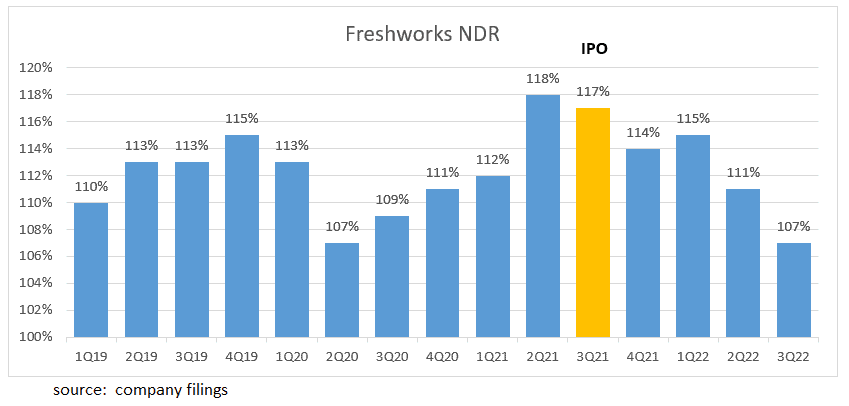
In Freshworks’ S-1 filing, they calculate NDR as follows.
“To calculate net dollar retention rate as of a particular date, we first determine “Entering ARR,” which is ARR from the population of our customers as of 12 months prior to the end of the reporting period. We then calculate the “Ending ARR” from the same set of customers as of the end of the reporting period. We then divide the Ending ARR by the Entering ARR to arrive at our net dollar retention rate. Ending ARR includes upsells, cross-sells, and renewals during the measurement period and is net of any contraction or attrition over this period.”
Freshworks S-1 Filing
They do on go on to explain nuances in NDR when calculating retention on monthly subscriptions.
Next Steps
Download my revenue template below. The formulas are like magic! If you can format your recurring revenue data like the screenshot below, you are in great shape. You can then paste your data into my revenue retention template to calculate your GDR, NDR, and logo retention metrics.
Today, it’s not just subscription revenue anymore. Business models now include usage, consumption, or transaction pricing models to name a few. You can also analyze your other recurring revenue streams with retention analysis.

I have worked in finance and accounting for 25+ years. I’ve been a SaaS CFO for 9+ years and began my career in the FP&A function. I hold an active Tennessee CPA license and earned my undergraduate degree from the University of Colorado at Boulder and MBA from the University of Iowa. I offer coaching, fractional CFO services, and SaaS finance courses.
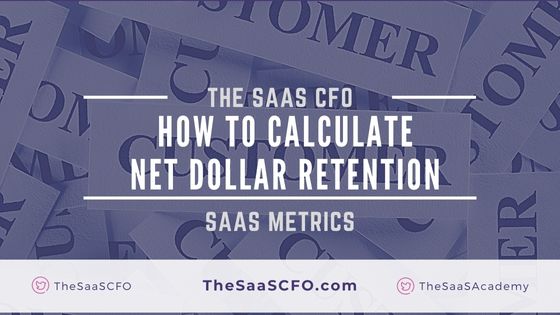
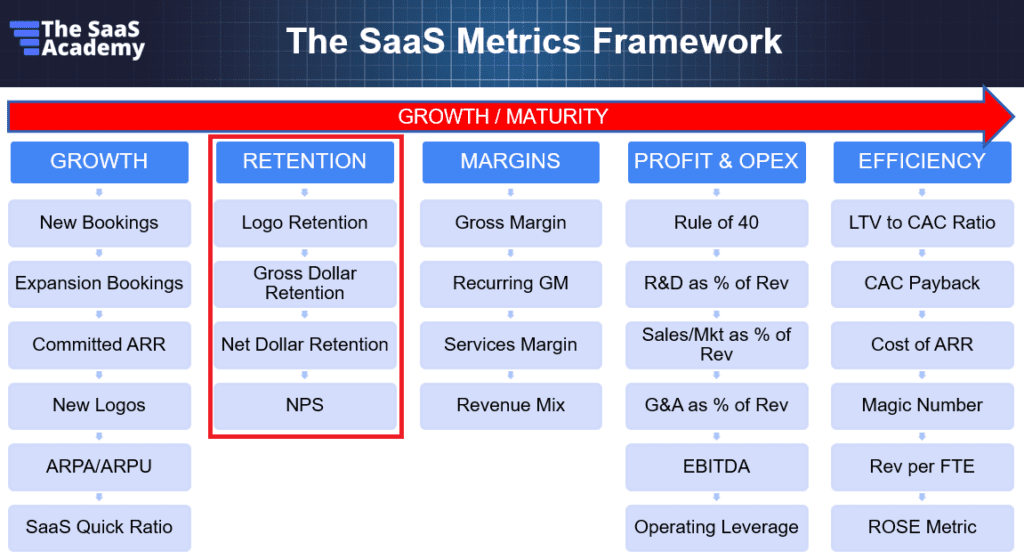

Ben – I find these very helpful and reinforces fundamental understanding of growth drivers in a SaaS business. Truly appreciate the clarity supported with examples and your efforts
Best…Anand
Good stuff as always, Ben. I’m particularly interested in enterprise B2B contracts that are mainly annual term plus a handful of pilots that generally only expand upon a renewal event. In this case, it seems fair to use “MRR up for renewal during the period” in the denominator, rather than total ARR (most of which does not have a renewal event, and would artificially depress NDR/NRR calculation).